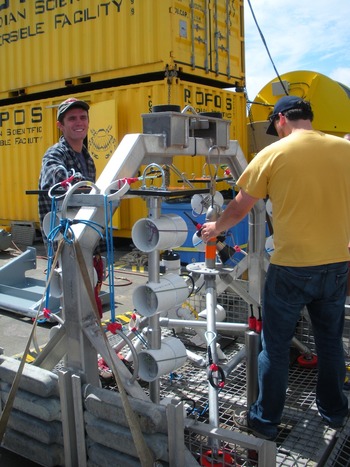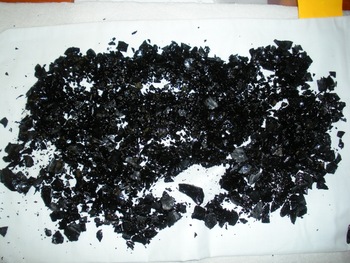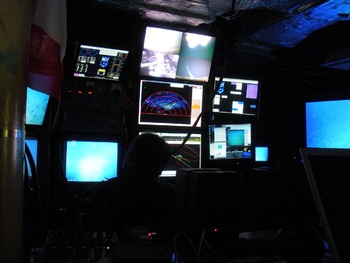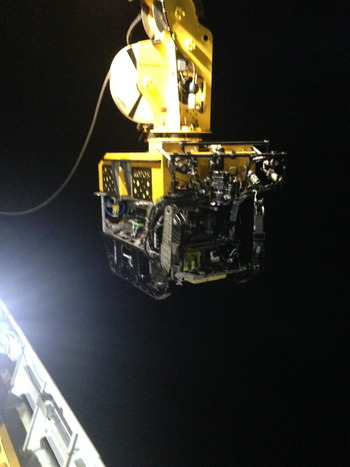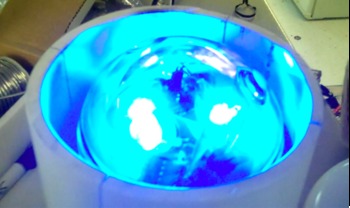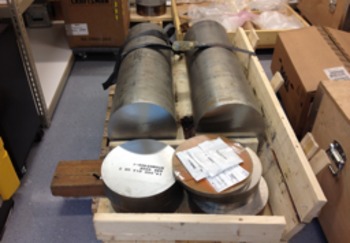Brendan Philip
End of Cruise
Wednesday, August 31, 2011
The cruise is coming to an end and we are heading into Victoria this afternoon. It was a bumpy night, but the sky is now clear and the sun is out! Land, here we come!
The glider was recovered on Monday, after spending about 1 week taking CTD readings and relaying them back to the ship via satellite. It anyone is interested in the data it sent back, here’s the link: http://marine.rutgers.edu/cool/auvs/index.php?pid=46 . I went up to the bridge to help sight the glider after it surfaced and I thought I saw it right away. But it turned out that yellow thing I thought I saw wasn’t a glider… False alarm!
Earlier in the week, I rode in the rescue boat to recover a transponder that had been cut from the sea floor. It was pretty amazing to have been in the ROV control room to watch the transponder get cut, then have to pull in 60m of slime-covered line in order to recover it. Note: Next time bring gloves.
New snow blowers were also discovered in the past few days, one of which was more massive than any of the previous ones found. I was at the camera controls when we stumbled across one… This was the most amazing thing I had ever seen on a T.V. The white microbes drifting out of the hole in the seafloor looked like stars; the entire scene looked like some sort of galaxy.
Last night was poetry night, for which we all shared our own creations or read from a stack of books. The night was a great way to end our time on station, and now we’re headed into Victoria for the last night of the cruise!
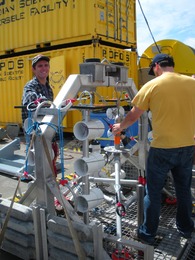
New Lava Flow & Snow Blowers
Wednesday, August 24, 2011
Yesterday we saw the new lava flow for the first time. Dark pillow basalts blanketed the seafloor in sharp contrast to the existing rock. The basalt practically crumbled under ROPOS’ grip, indicating that it was still very young rock. This rock is at most three months old. Compare this to the rocks found back on land, which can be hundreds of thousands of years old. This is amazing!
At one point we came across what is known as a snow blower; a chasm opening up from the new flow, revealing colonies of white microbes lining the walls. Chunks of microbes were slowly spewed from the hole, being carried off by hot gas and water, drifting into the deep. These colonies were only recently discovered and suggest that microbes can survive beneath the surface in extremely high temperatures. We took some samples and a temperature reading, though the temperature probe proved to be faulty.
The sensor bot experiment is going in the water today. The bots have been reprogrammed and the camera has been mounted, we’re set to start the new dive soon. The orbs are attached to stands that will be placed around the camera, which will record the bots flashing and store the video on a computer housed in ½ inch titanium tubes. We will pick up the bots in about a week, when the footage will be processed.
We will be going to Ashes vent field tonight…there should be black smoker vents and tube worms at every turn! Watch that live feed!
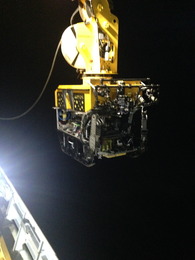
ROPOS & Mapping
Tuesday, August 23, 2011
Good morning! We have reached Axial seamount and have begun mapping and surveying the caldera of the volcano. The volcano erupted recently and we are looking to see where the new lava flows are and what they look like. I have been working with the software that images the multi-beam sonar data that has been collected so far and have been producing amazing images!
We completed the cable survey last night after following the as-laid rout to see what the rout actually looks like. There were several areas where the cable was suspended above the seafloor, most notably a section that ran directly through the vent of a black smoker. The temperatures there can reach several hundred degrees… so that cable might have to be moved!
Each of us onboard has assigned shifts; mine is from 4 am to 8 am. My job is to work with the HD camera aboard the ROV (remotely operated vehicle) ROPOS. There are at least 23 flat screen TVs and monitors spread around the control room, monitoring everything from height above the seafloor to where the ROV is in relation to the ship. The picture clarity is amazing, so make sure to check out the live video feed!
The glider was deployed on Sunday and has been returning data every three hours. The glider is making salinity measurements, taking temperature readings and reporting ocean density. It has been circling the ship and been automatically uploading the data online when it returns to the surface. Check it out! (http://marine.rutgers.edu/cool/auvs/index.php?did=223)
If anybody has any questions they want answered, shoot me an email and I’ll see if I can get it answered! brendan.t.philip@gmail.com
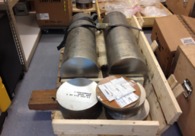
Sensor Bots & Glider
Sunday, August 21, 2011
Today is the first full day on the water for Leg 2 and we are currently in transit to Axial sea mount, located at the edge of the Juan de Fuca tectonic plate. The bunks are comfortable and I had a great night’s sleep!
The day started out with a fire drill and safety talk, during which time we had a contest to see who could put on their survival suit first. I then helped to assemble some sensors that will be deployed to the seafloor later in the week and will measure pH, temperature and O2 concentrations. These sensor bots can contain other instruments and transmit data to a camera through a sequence of blue flashes. The goal of these sensors is to be able to collect data over a large area using only light transmissions. The flashing light is mesmerizing!
Also aboard the ship is a glider from Rutgers University, which will be deployed tomorrow and remain at sea until the end of the cruise. The glider can travel to a depth of 1000m (~3000ft) and will collect conductivity, temperature and density readings. The glider is programmed to return to the surface every 3-4 hours, where it will transmit its readings via satellite and can be reprogramed to reach a new waypoint.
The goal of this cruise is to figure out where best to place instruments and cables along the seafloor so that this region can be monitored continuously from ashore. Part of the goal is to find routs for instruments as to limit damage caused by future lava flows. The volcano erupted sometime in the last few months, so it is possible that there are new routs to be planned!
The remotely operated vehicle (ROV) onboard should be deployed sometime Sunday, so keep an eye on the live stream!

